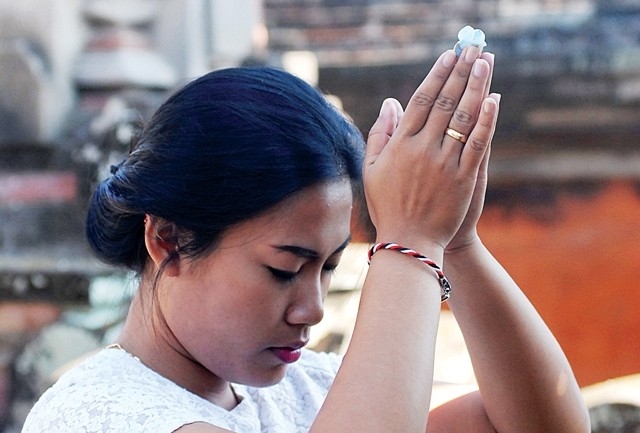
Often on the wrists of Balinese people, we see thread bracelets woven with red, white, and black threads. Some tourists look for places to tie such bracelets, considering them talismans for "making wishes come true." But what meaning do the Balinese themselves attribute to these bracelets?
Such a bracelet made of threads in three colors is called Tridatu. "Tri" comes from the word "three," which is universal in many Indo-European languages. And "datu" can be translated as "power" or "energy."
In the intertwining of colors, red is associated with the Hindu god Brahma, the creator of the world, who is revered in central village temples in Bali, such as Pura Desa.
Black symbolizes the protector and defender of the world, the god Vishnu. He is worshipped in the Pura Puseh temples, which are located in villages on the side facing Mount Agung.
White is the color symbolizing the god Shiva, the destroyer and transformer. Temples dedicated to Shiva, called Pura Dalem, are situated in villages on the side facing the ocean.
This trinity is also called Trimurti, and it is believed that the three gods united in it are manifestations of the supreme Balinese god, Sanghyang Widhi Wasa.
Another, more simplified interpretation of the color combination is a reflection of the interconnected process of birth, life, and death in the world.
Another, more simplified interpretation of the color combination is a reflection of the interconnected process of birth, life, and death in the world.
Sometimes, such Tridatu bracelets are worn by Balinese not only on the wrist but also around the neck as a necklace.
In Bali, there's a legend about the origin of these bracelets. In the 14th or 15th century, the ruler of Bali, Dalem Watu Renggong, defeated the ruler of Nusa Penida, Dalem Bungkut. They made an agreement in which Dalem Bungkut surrendered Nusa Penida's control to Dalem Watu Renggong. However, he requested protection for the Hindus who had shown devotion to the gods. It was these devout citizens who were given Tridatu bracelets to wear on Nusa Penida at the Pura Dalem Ped temple.
In modern times, Tridatu has become a symbol of Bali that can be worn by any Hindu. According to Balinese beliefs today, these bracelets are tied for protection against negative forces, to avoid misfortunes, and to behave more wisely.
Balinese people believe that the bracelet can protect against visible misfortunes, which are reflections of the explicit, visible world - "sekala," such as accidents, thefts. Additionally, they believe in the bracelet's ability to safeguard against negative forces that can arise from the unseen, hidden from the world's eyes, known as "niskala." Negative forces that harm people from the hidden world include demons, werewolves, witchcraft, and poisons.
In a genuine ceremonial bracelet from the temple, the threads must be wound spirally, not braided or woven like typical hairstyles or friendship bracelets.
Bracelets are crafted by priests in a special ceremony held on auspicious dates. During festive days, after prayers and blessings, Balinese people receive these bracelets in the temple. It's believed that one should wear it until it naturally wears out and falls off the wrist.
Balinese individuals wear the bracelet on their right hand, which is considered proper and pure. According to beliefs, wearing Tridatu on the left hand will cause it to lose its magical power.
Sometimes, "kepeng" coins or Chinese coins are woven into or threaded onto the bracelet. These coins are an important talisman in Balinese culture. Kepeng coins were commonly used for monetary transactions on Bali until the mid-20th century. It is believed that a wearer of Tridatu with a kepeng is under the protection of four gods (Pancha Deva), who oversee the four cardinal directions, and an additional central deity.
Foreigners have taken a liking to Tridatu bracelets. Such adornments can be purchased in souvenir shops and online stores. The Balinese clergy does not object to non-Hindus wearing Tridatu because there is no information in the sacred Balinese scriptures (lontars) against this practice. An authoritative Balinese spiritual source regarding this usage is the Agastya Parwa scripture.
The main restriction on wearing Tridatu is that they cannot be worn on the foot, as this could offend devout Hindus. In this religion, feet are considered impure, and placing symbols of the gods in impure places is unacceptable.
Based on materials from jawapos.com and the scholarly publication "Commodification of Tri Datu Bracelets Talisman in Balinese Community."
You can add one right now!